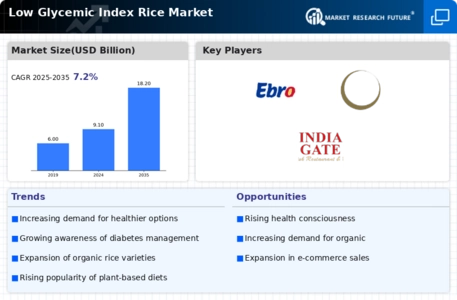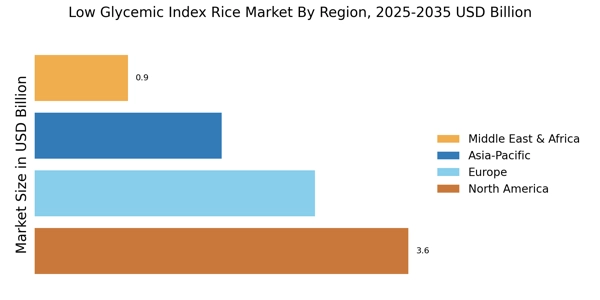The Low Glycemic Index Rice Market is currently characterized by a dynamic competitive landscape, driven by increasing consumer awareness regarding health and dietary choices. Key players such as Lundberg Family Farms (US), Tilda (GB), and Uncle Ben's (US) are strategically positioning themselves through innovation and product diversification. Lundberg Family Farms (US) emphasizes organic and sustainable farming practices, which resonate with health-conscious consumers. Tilda (GB) focuses on premium quality basmati rice, leveraging its heritage and brand reputation to capture market share. Meanwhile, Uncle Ben's (US) has been actively reformulating its product lines to enhance nutritional profiles, thereby appealing to a broader audience concerned with glycemic index levels. Collectively, these strategies contribute to a competitive environment that prioritizes health benefits and quality over traditional price competition.
In terms of business tactics, companies are increasingly localizing manufacturing and optimizing supply chains to enhance efficiency and responsiveness to market demands. The Low Glycemic Index Rice Market appears moderately fragmented, with several players vying for dominance. However, the collective influence of major companies is significant, as they set trends and standards that smaller entities often follow. This competitive structure fosters innovation and encourages new entrants to adapt to evolving consumer preferences.
In August 2025, Tilda (GB) launched a new line of low glycemic index rice products aimed at the health-conscious segment, which is expected to bolster its market presence. This strategic move not only aligns with the growing trend of healthier eating but also positions Tilda as a leader in the premium rice segment. The introduction of these products reflects a keen understanding of consumer needs and a commitment to innovation, which could potentially enhance brand loyalty and market share.
In September 2025, Lundberg Family Farms (US) announced a partnership with a leading health food retailer to expand its distribution channels. This collaboration is likely to enhance the visibility of its low glycemic index rice offerings, making them more accessible to consumers. By leveraging the retailer's established network, Lundberg aims to tap into new customer segments, thereby reinforcing its market position and driving sales growth.
In October 2025, Uncle Ben's (US) unveiled a new marketing campaign focused on educating consumers about the benefits of low glycemic index rice. This initiative is expected to raise awareness and drive demand for its products, particularly among health-conscious consumers. By positioning itself as an advocate for healthier eating, Uncle Ben's seeks to differentiate its brand in a crowded marketplace, potentially leading to increased consumer engagement and loyalty.
As of October 2025, current competitive trends in the Low Glycemic Index Rice Market are increasingly influenced by digitalization, sustainability, and the integration of artificial intelligence in supply chain management. Strategic alliances are becoming more prevalent, as companies recognize the value of collaboration in enhancing product offerings and market reach. Looking ahead, competitive differentiation is likely to evolve, with a pronounced shift from price-based competition to a focus on innovation, technology, and supply chain reliability. This transition suggests that companies that prioritize these aspects will be better positioned to thrive in an increasingly health-conscious market.


















Leave a Comment